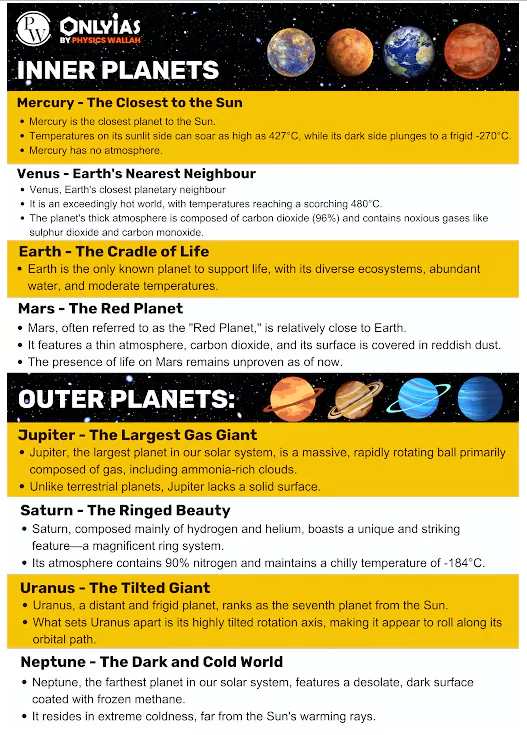Our solar system is like a bustling neighbourhood in space, with the Sun at its heart, surrounded by an entourage of planets, moons, and other celestial objects. Imagine it as a giant family, with each member playing a unique role and having its own distinct characteristics.
Our Solar System and Earth
- The solar system is a celestial system, including a star and orbiting objects, bound by gravity.
- Our solar system consists of the Sun (central star), 8 planets, millions of smaller bodies like asteroids and comets and huge quantities of dust-grains and gases.
- It orbits the Milky Way Galaxy and is located in the Milky Way’s outer spiral arm (Orion), disc-shaped.
- Inner or Terrestrial Planets: Higher densities, smaller in size, and their lower gravity could not hold the escaping gases; Formed in close vicinity of the sun, it was too warm for gases to condense to solid particles.
- Intense solar winds blew off gases and dust, thus, leading to formation of Solid rocky surface.
- Example: Mercury, Venus, Earth and Mars.
- Outer or Jovian Planet: Lower densities and bigger in size; Formed at a distant location from the Sun, less intense solar winds resulted in retention of gases and formation of Dusty gaseous surface.
- Example: Jupiter, Saturn, Uranus and Neptune
- Eight Planets: Mercury, Venus, Earth, Mars, Jupiter, Saturn, Uranus and Neptune.
- Mercury: smallest and nearest to the Sun.
- Venus: It is considered Earth’s-twin (similar shape and size).
- It is probably the hottest planet (the atmosphere contains 90-95% of carbon dioxide with clouds of sulfuric acid).
Enroll now for UPSC Online Course
- Jupiter: It is the largest planet in the solar system. Its atmosphere contains hydrogen, helium, methane and ammonia.
- Unique Rotational Characteristics of Venus and Uranus: The tilt of the rotational axis of Venus and Uranus is so great that these planets actually rotate in a direction that is opposite to the other planets.

The Moon
- The Moon is the only natural satellite of the Earth. Its diameter is only one-quarter that of the Earth.
- Rotation and Revolution: The moon is tidally locked to the earth, meaning that the moon revolves around the earth in about 27 days, which is the same time it takes to complete one rotation.
- As a result of tidal locking, only one side of the moon is visible to us on the earth.
- Formation: Generally, it is believed that the formation of the Moon is an outcome of giant impact or what is described as the big splat.
- Super Moon: When the moon is at the minimum distance from the earth; also referred to as perigee or full moon. The moon appears 14% larger and 30% brighter.
Earth
- Earth is the fifth largest planet in the solar system; it is also called Blue Planet as two-thirds of its surface is covered by water.
- Shape: Geoid (oblate spheroid) – slightly flattened at the pole and bulging at the Equator.
- Goldilocks Zone: Earth lies in the Goldilocks Zone – water can exist in a liquid state.
- Densest planet in the solar system.
- Speed of Rotation: around the axis is maximum at the equator and decreases poleward.
- Axis of the Earth: It is an imaginary line that makes an angle of 66½° with its orbital plane.
Conclusion
The Sun, the central star, is surrounded by eight diverse planets, moons, and countless other celestial bodies. From the rocky surfaces of Mercury to the swirling storms of Jupiter, each planet tells a unique story of its formation and characteristics. Earth, our home, stands out as a precious oasis, nestled in the perfect “Goldilocks Zone” where life thrives amidst the wonders of the cosmos.
![]() April 26, 2024
April 26, 2024
![]() 1646
1646
![]() 0
0
